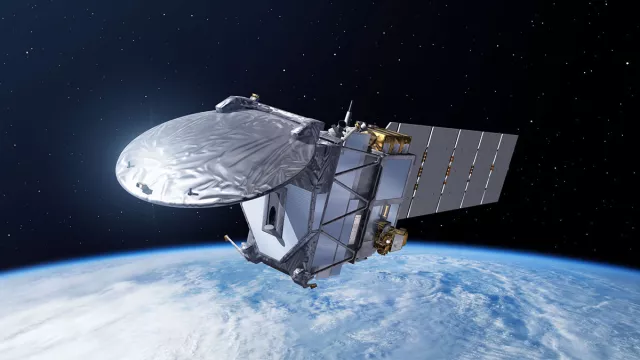After its launch in 2024, the European-Japanese EarthCARE satellite and its four instruments will probe the cloud layer and its radiative interactions to gain new insights into how the atmosphere regulates our planet’s temperature.
Key information
| Mission | Map clouds and their radiative mechanisms |
|---|---|
| Domain | Earth observation |
| Launch date | 28 May 2024 |
| Partners | ESA, JAXA |
| Where | Sun-synchronous orbit (SSO) at an altitude of 394 km |
| Lifetime | 3 years |
| Status | In operation |
Key figures
- 9-day revisit frequency
- 2.5-m-diameter antenna
- 2,350 kg: satellite mass
- 4 instruments
Key milestones
- 2024: EarthCARE launched by Falcon 9
- 2014: Integration of instruments
- 2009: Satellite design and construction
- May 2008: ESA awards contract to build satellite to EADS/Astrium
- December 2004: EarthCARE selected as 6th mission of ESA’s Earth Explorer programme
- November 2001: Phase A of EarthCARE development project
- 2000: EarthCARE down-selected by ESA
Project in brief
The cloud layer plays a key role in Earth’s climate, absorbing and reflecting part of the Sun’s radiation back into space. But clouds also play an opposite role, trapping a fraction of the heat emitted from the planet’s surface in the form of infrared radiation.
The EarthCARE satellite (Earth Cloud, Aerosol and Radiation Explorer) is designed to analyse these two hard-to-study phenomena with unprecedented precision. From its vantage point in low Earth polar orbit inclined to view any point on the globe, EarthCARE will collect data to generate 3D maps of the cloud layer and aerosols, while measuring exactly how much solar and Earth radiation they reflect. With its nine-day revisit rate, the satellite will be able to acquire comparative time-series of data over several years.
Science teams are eagerly awaiting the results from this sixth ESA Earth Explorer mission to refine their meteorological models and learn more about the processes driving global warming and its consequences.
EarthCARE is carrying two active instruments: ATLID (Atmospheric Lidar) and CPR (Cloud Profiling Radar), supplied by the Japan Aerospace eXploration Agency (JAXA). ATLID employs a laser beam pointing down vertically beneath the satellite to remote-sense the altitude of the cloud layer, while CPR is a precision Doppler radar able to determine cloud composition. CPR’s large 2.5-metre antenna gives the satellite its unique profile.
The payload also includes two passive instruments, MSI (Multi-Spectral Imager) and BBR (Broad-Band Radiometer), which will characterize the cloud layer and aerosols in different frequency bands and sense radiation reflected back into space.
CNES’s role
CNES supported and directly funded work to prepare the EarthCARE mission at several French research laboratories: IPSL (Institut Pierre-Simon Laplace), the LATMOS atmospheres, environments and space observations laboratory, the LMD dynamic meteorology research laboratory, the LSCE climate and environmental science laboratory, the LPC2E environmental and space physics and chemistry laboratory, the LAERO aerology laboratory, the LACy atmosphere and cyclones laboratory, the LaMP physical meteorology laboratory, the LOA applied optics laboratory and the ILM light and matter institute.
CNES is also funding instrument CALibration/VALidation (CAL/VAL) activities.
Lastly, France, through CNES, is co-funding ESA’s Future-EO programme and its Earth Explorer missions, of which EarthCARE is one
Contacts
Atmospheric Physics & Meteorology subject matter expert
Adrien Deschamps
E-mail: adrien.deschamps at cnes.fr


